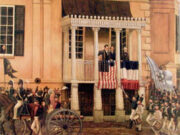Marie Joseph Paul Yves Roch Gilbert du Motier, Marquis de Lafayette (1757-1834), came to the United States from France at the invitation of Congress and toured all twenty-four states between August 1824 and September 1825. Lafayette had fought in the Revolutionary War (1775-83) at the crucial Battles of Brandywine in Pennsylvania and Yorktown, Virginia, and in his old age, he hoped to attend ceremonies for the fiftieth anniversary of Boston’s Bunker Hill in 1825. His friend U.S. president James Monroe prompted Congress to extend the invitation for Lafayette to visit the United States one final time. To honor the last surviving Revolutionary War major general, Georgia governor George M. Troup arranged an elaborate journey across the state from the coast and the inland cities to the Creek lands in the west.
Arriving in Savannah on March 19, 1825, the sixty-seven-year-old Lafayette disembarked from his steamboat to a salute from the Chatham Artillery and the cheers of the crowd. The most poignant moments of his stay in Savannah came when he laid the cornerstones for monuments honoring two other Revolutionary War heroes, Count Casimir Pulaski and General Nathanael Greene.
Accompanied by his son, his secretary, and Governor Troup, Lafayette traveled up the Savannah River by steamboat and arrived in Augusta on March 23. In both Savannah and Augusta, he received delegations of French descendants. He extended his overnight stay in Augusta by an additional day to allow time for a public banquet and a ball. The general, suffering “a fatigue,” presided over the ball seated beneath a canopy of silvered lace.
Lafayette’s party traveled inland from Augusta on the Milledgeville Stage Road. The road was so treacherous with potholes and ruts that the four-horse carriage nearly broke down, and the general became ill from the jolts. After resting overnight in Warrenton, Lafayette continued on to Sparta and then to the capital, Milledgeville, where he arrived on March 27.
He met first with Revolutionary War veterans; Lafayette was delighted to find the man who helped carry him off the battlefield at Brandywine, where he had been wounded. Governor Troup hosted the general at an outdoor supper and ball in the emptied state capitol building.
The schedule then called for Lafayette to travel the 120 miles from Milledgeville to Fort Mitchell, on the Alabama side of the Chattahoochee River, in two arduous days. Accordingly, he left the capital early on March 29 and reached Macon by midday. Lafayette paused for lunch with the townspeople but journeyed on that afternoon to the Old Creek Indian Agency in western Crawford County.
Travel west of Macon was through Creek lands, where both roads and accommodations were primitive. The coach, scraping bottom in a gully, nearly shattered. The party’s progress was also slowed by a thunderstorm in present-day Marion County, where Lafayette joined a group of Creeks at a tavern to dry his clothes in front of the fire. Miles away from their destination of Fort Mitchell, the entourage spent the night in bark-covered log cabins at a stage stand in present-day Chattahoochee County. The next day, March 31, Lafayette finished his thirteen-day, four-hundred-mile trek across Georgia and crossed the Chattahoochee into Alabama. Lafayette completed his circuit of the nation that spring by visiting all the southern and western states before returning to Massachusetts for the Bunker Hill celebration in June 1825.
In 1836 the county seat of Walker County was named LaFayette in his honor.




